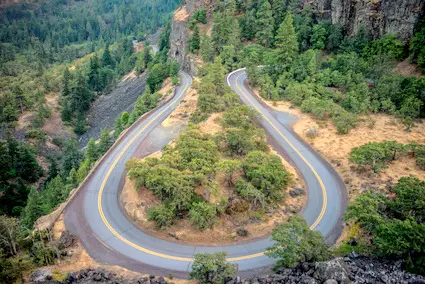Safety Tips for Driving in the Mountains
Nothing beats the freedom of a road trip. Being able to explore a country at your own pace allows you to pull off and check out attractions as frequently as you wish. Road trips are generally thought of as being almost carefree, but this largely depends on the terrain you’re travelling through. If you plan on taking a drive through the mountains, a great deal of preparation is needed do to the fact mountain roads are some of the most dangerous you can face.
The weather can change drastically and quite rapidly in the mountains. This often results in already dangerous driving conditions becoming even more hazardous. Thankfully, there are many ways you can prepare both your car and yourself to make sure you’ll be able to handle most of what you may face. Whether you’re planning on driving through the North America’s Rockies or Appalachian Mountains, the European Alps, or South America’s Andes, be sure to follow these top mountain driving safety tips before hitting the road to ensure the safety of your vehicle and yourself.


Have Your Car Serviced
One of the most important things you should do before planning a road trip through the mountains is to get your car serviced. This means getting an oil change and topping up all your fluids such as your vehicle’s brake and transmission fluids. You’ll definitely be using your brakes often, so you must make sure they are in good working order. Don’t forget little things like topping up your windshield washing fluid since driving on gravel mountain roads can get your windows dirty in no time. Check your windshield wipers as well since it often rains in the mountains and you want to make sure you always have proper visibility in inclement weather.
Harsh terrain can be rough on your vehicle, so it pays to make sure your vehicle’s suspension, belts, and other mechanics are all working properly. Make sure your vehicle’s heating and cooling systems are working properly in case you happen to break down and need to rely on either to keep you comfortable or alive. Carry an extra bottle of coolant or jug of water, especially when driving through mountainous desert areas. Going uphill in extreme temperatures can easily cause your car to overheat. Of course you also want to check your tires, but more on those later.
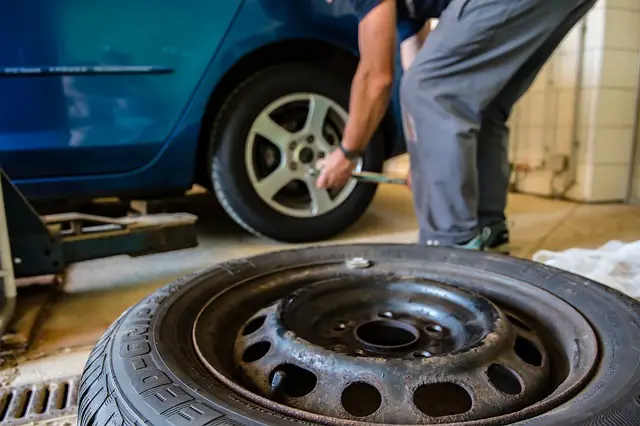
Avoid Alcohol
It pretty much goes without saying that you should never drink and drive, but this becomes even more vital when driving in the mountains. Mountain driving requires you to be focused on the road 100% of the time due to hairpin turns, steep inclines, and abundance of wildlife about. According to Tennessee DUI lawyer John Barnes, being arrested for a DUI is not only a traumatic experience for many, but it can also lead to some serious consequences including hefty criminal convictions.
Alcohol can blur your vision, causing you to easily misjudge distances and not stick within your lane. Drinking may also reduce your eye-hand-foot coordination, slow down your reaction time, cause drowsiness, and prevent you from making rational decisions. Don’t think that simply sleeping off a night of drinking in a rural mountain bar will be enough to completely sober you up.
Avoid taking drugs as well which can affect your ability to drive properly. Even prescription drugs can affect your driving so make sure to ask your doctor if your medication is safe to take while driving and stick to the recommended dosage.

Check the Weather
It is vital to know what weather you may face while driving in the mountains. Keep a close eye on the weather forecast each day and know that it is always better to over prepare than to be caught out in a storm without the needed essentials.
Temperatures can drop considerably the higher in altitude you drive. You may get away with wearing shorts and a t-shirt at lower elevations but may need a hefty coat and beanie upon reaching a summit. Both snow and heavy fog can be present higher up in the mountains even it is completely clear on the roads further down.
It is a good idea to always keep your headlights on while driving in the mountains, but switch to fog lights when driving in fog and use high beams at night to better avoid collisions with crossing wildlife. Remember to turn off your high beams when passing another vehicle at night.
Carry a rain jacket and umbrella if you plan on enjoying some off-road hikes and possibly winter weather gear if it is warranted. If a severe storm with lightning strikes, pull over when it is safe to do so and remain in the vehicle. Park under shelter if possible but avoid parking near trees that may attract lightning or fall on your vehicle. Remember to turn on your hazard lights as you wait out the storm. Remember that wet or icy roads require a greater stopping distance, so slow down and refrain from following too closely to another vehicle in such conditions.
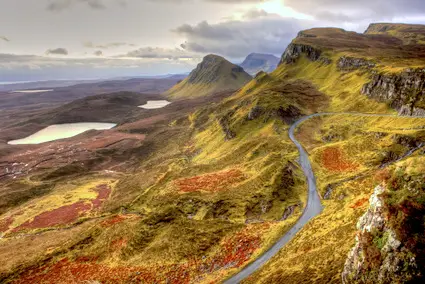
Plan Your Route and Fuel Up
The last place you want to run out of fuel is remotely in the mountains. It’s important to not only fully fuel up before heading into the mountains, but to also carefully plan out your route before hand to be sure there will be places to fill up in-between where you currently are and where you’re going.
If fuel stations won’t be available, be sure to carry extra fuel cans with you. These should never be stored inside the vehicle cabin. Instead, transport them in the back of a pickup/ute, on a roof rack, or at the back of the vehicle in a jerrycan holder. You can also look into equipping your vehicle with a long-rage fuel tank which can be added to your vehicle to replace your exiting fuel tank or as an additional tank to your standard one.
It’s important to remember that driving up steep inclines will use up more fuel and fuel stations become sparser in remote locations. Fuel prices can also be considerably higher in remote locations. Having enough fuel is not only important for getting you places, it can also provide you with heat or air conditioning should you experience a breakdown and need it to deal with harsh weather.

Tire Safety
Mountain driving can be rough on your tires, especially when driving on gravel or dirt roads. Be sure to check your tires before heading out to make sure they are properly inflated to the manufacturer’s recommended PSI. You want to make sure all tires have plenty of tread left and pack a spare tire, preferably a full-size spare. Carry a car jack and tire repair kit as well in case of multiple flat tires.
To increase your vehicle’s traction in deeper snow and sand or ice, you can deflate the tires a bit to increase the amount of rubber that makes contact with the driving surface. Be sure to inflate the tires once again when returning to normal roads and highways. The reason for this is that underinflated tires can overheat and possibly explode. They also reduce your fuel economy as well as your vehicle’s handling.
Mountain driving may also require you to carry snow chains for your tires depending on the season. Some roadways may even prohibit you from driving on them at times if your tires are not fitted with snow chains.

Braking
You should also know how driving in the mountains affects breaking. Always comply with posted suggested speed signs placed on downhill grades and around sharp corners or winding roads. As you drive downhill, your vehicle gathers momentum which can make it more difficult to break and control your vehicle. The key to sharp turns is to break early and coast or even accelerate a bit through each turn.
Be sure to break before upcoming downgrades and follow the pulse or pump break method. This method involves you pumping the breaks at intervals as you try to maintain a safe driving speed instead of riding your breaks for extended periods of time. Your brake pads heat up as you apply your brakes, causing them to be less effective the hotter they get. The pulse braking method gives your brake pads a chance to cool down so they don’t overheat and become dysfunctional.
When driving a manual transmission vehicle, shift to a lower gear before you reach a downgrade instead of when you are already heading downhill.
Road Etiquette
While drivers should always practice good road etiquette, there are a few road manners that are essential when driving in the mountains. When coming around blind bends, you may want to briefly honk your horn to alert passing drivers that there is another vehicle present. Never hug the center line, especially since mountain roads are often narrower than standard roads and two passing vehicles hugging the center line can lead to a bad accident.
Never tailgate when driving in the mountains as there are often more hazards that may cause a vehicle in front of you to stop quickly. This may include crossing wildlife, potholes, ice, or sharp bends. When passing another vehicle on narrow roads with steep inclines, the vehicle driving uphill generally has the right of way.
There are often a number of exceptional views to take in while driving in the mountains, and you are encouraged to pull off to grab photos or simply admire the view. However, you should always pull over only when it is safe to do so, leaving plenty of room for other vehicles to pass through unimpeded. You should also use dedicated pull outs or pull over when it is safe to do so to allow other vehicles to pass if you wish to go slower than the vehicles traveling behind you.
At night, be sure to turn off your high beams when passing another vehicle so as to not blind them.
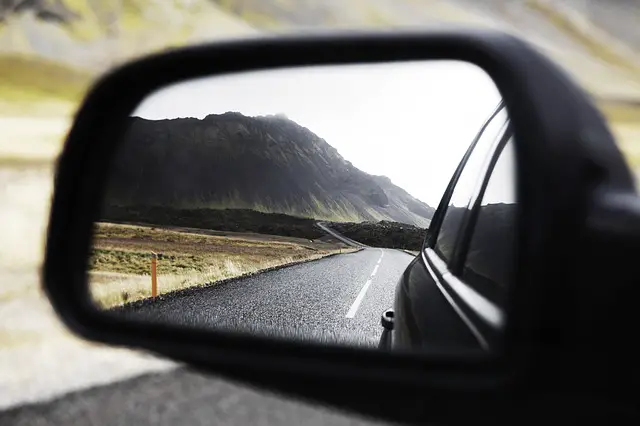
Carry Essential Supplies
Consider bringing backup custom-fit car accessories if traveling far and staying outdoors for an extended period. This way, you have replacements in case there’s a mess in your vehicle. This is more likely to happen if you’re traveling with kids, pets, or both. No one wants to stay cooped up in a messy, smelly, cramped vehicle, so be ready with replacement seat covers and mats, along with a travel-friendly car cleaning kit.
Always pack a dedicated break down kit and gear for inclement weather. Because cell phone coverage may be nonexistent, you may have to rely on your own supplies to get you out of the mountains should you break down.
Always have your vehicle’s handbook with you if you are less car-savvy. You handbook will often guide you through how to make minor repairs such as changing a tire. Carry jumper cables in case you or another driver has a flat battery and pack a shovel and tire chains in case of snow.
Always carry plenty of drinking water and food, remembering to pack extra in case you become stranded. It may take hours or even days for assistance to reach you, so you want to make sure you have everything you need to survive in the mountains. Higher elevations can dehydrate you more quickly and this can in turn lead to more severe altitude sickness.
It is a good idea to let family or friends know about your road trip itinerary. Plan to check in with them at set intervals. If you fail to check in at a scheduled date or time, they can send help if your tardiness in contacting them becomes severe. They will at least have an idea of where you may be located if they have your itinerary.

Take Breaks
Driving in the mountains is not only strenuous for your vehicle, but it also places more demands on your mind and body. Mountain driving forces you to stay more focused on the road and this can cause you to become fatigued much more quickly.
Plan driving breaks to stretch your legs and get some food. Do driver swaps if you’re road tripping with others, so as to always have a well-rested and alert driver. If you’re driving solo, always pull over if you need to make or take a call.
Be sure to take breaks more often than you would under normal driving conditions. Taking breaks allows you to take in the scenery and gives your vehicle a chance to rest as well, something that is important when driving in hot weather so as to keep your engine from overheating.
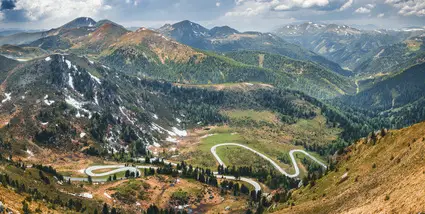
Conclusion
While driving in the mountains does require a bit more planning and care, it makes up some of the best road trips out there. Following these safety tips will hopefully allow you to enjoy a safe and adventurous mountain driving experience. Of course you can’t always prepare for what other drivers on the road will do, but staying alert and being aware of the many pitfall of mountain driving should allow you to better avoid potentially dangerous situations.

